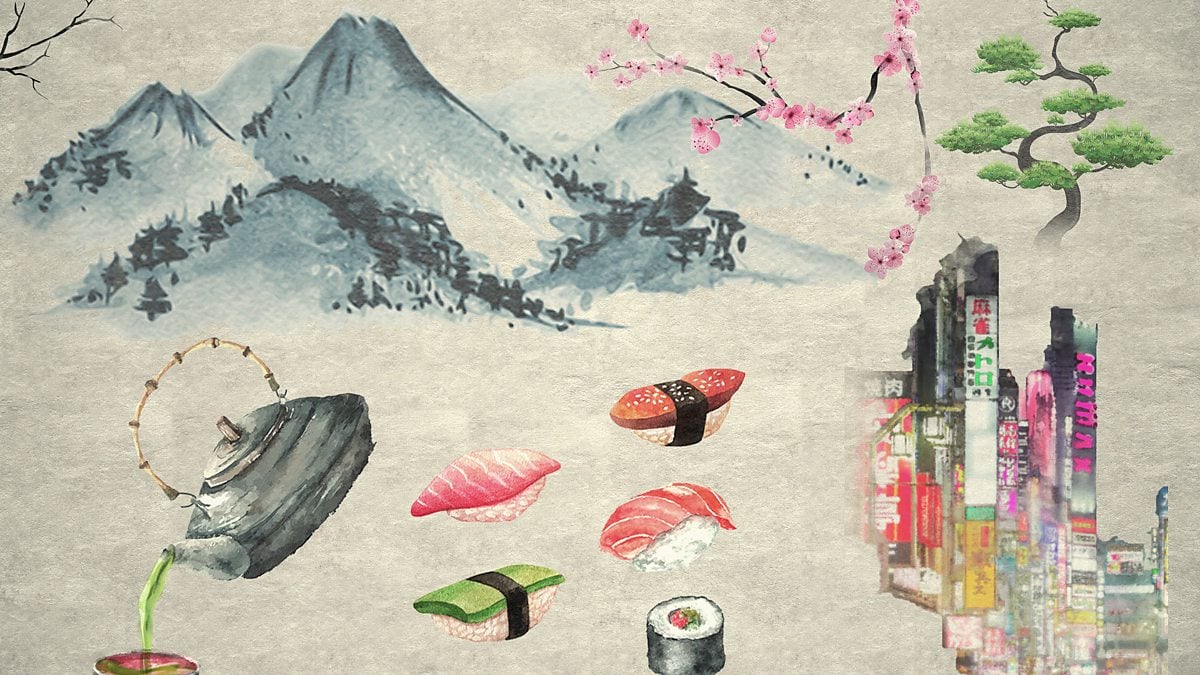If you had to sum up an art history documentary in one word, ‘dynamic’ would not be the first adjective to spring to mind, but the passion of Dr James Fox for his subject helps the BBC series The Art of Japanese Life to challenge such expectations.
As the title suggests, the documentary looks at varying aspects of Japanese culture, or ‘art’, through three broad lenses – ‘Nature’, ‘Cities’, and ‘Home’. On one level, the programme follows the development of the country’s fine art, from the monochromatic, splashed-ink landscapes of 15th century Buddhist monk Sesshu, to the modern-day calligraphy of Tomoko Kawao (whose works are painted with brushes so large that they constitute, what Fox calls, an “art of the body”, not just the hand).
Viewers are given a glimpse of more formalised culture in the shape of the stylised and subversive kabuki theatres of Edo (now Tokyo) and the twelfth century handscroll illustrations of the Tale of Genji, a remarkable work which was written by the lady-in-waiting Murasaki Shikibu and is considered the world’s first novel. A proverbial feast for the eyes is also created by the kaleidoscopic lighting displays of renowned artist Yayoi Kusama’s Infinity Mirror Rooms, which also prompt the perennial question of how we define art, especially the conceptual type.
This question seems key to the documentary, which also seeks to resist the clichés of cherry blossoms and Mount Fuji, often associated with Japanese painting. For example, Fox discusses the stark contrast between the ideal of ‘zen living’, espoused by companies like Muji, and the reality of tiny Tokyo apartments. In doing so, the series shows how art can be located in spaces far removed from the gallery, how it can fulfil an unexpected but fundamental role in our own lives, and how Japanese culture, in particular, seems to blur this distinction between art and life.
This is portrayed in the documentary through the production of an exquisitely designed, spring-themed bento box, revealing the meticulous crafting of everyday items. However, the idea is also examined through the encompassment of areas not typically considered ‘art’ within the series: the history of Japan’s cities, the country’s declining economy, the politics of construction in Tokyo, and the widespread cultural influence of China.
The manifestation of the essential link in the Japanese consciousness between nature and the religions of Shintoism and Buddhism is explored too. Viewers, as such, become wrapped up in the philosophical thread that is entwined with every object shown on camera: reflections of the meaning of life are to be found in ikebana – the art of Japanese flower arranging – and the fantastical buildings designed by architect Terunobu Fujimori, as well as Daido Moriyama’s photographic vision of Tokyo’s underbelly.
Similarly, concepts specific to Japan, such as ma – the idea of empty space being as significant as the landscape it surrounds – are illustrated for the viewer, not only in visual art but also in real life: for instance, in the endless room created by the moveable doors and walls of the traditional Japanese interior at the Rinshunkaku, a villa built by the Samurai Lord Yorinobu.
Fox’s comments on how Japanese cities can be “aggressively ugly places” make the viewer question how important it is to imagine that the places in which we live and work should be aesthetically pleasing. Perception, both literally and metaphorically, is another aspect repeatedly contested in the series. Fox ingeniously reinterprets Hokusai’s ubiquitous painting ‘The Great Wave off Kanagawa’: for Westerners, it is a popular image as they view it from left to right, therefore travelling with the wave. Yet this same artwork seems terrifying to Japanese audiences who, viewing it from right to left, travel – like the fishermen depicted in it – against the wave.
At times though, the documentary feels too drawn to the details, even for a literature student like myself, used to waffling my way through essays. Fox informs the audience that a piece of raku pottery, used in the Japanese tea ceremony, is not simply a bowl: it is a lesson to all of us to appreciate the simpler things in life. Such moments left me wishing the presenter would sometimes just see an object as it was, rather than always as a symbol for something else.
The tensions highlighted in the series between the past and present, permanence and impermanence, and respecting and controlling nature can seem an overly simplified way of defining Japanese society. Nevertheless, such conflicts are subtilized and reconciled through the art and aesthetics surveyed in the series to give a more nuanced outlook on the country.
Fox speaks throughout the series of the “visual grammar” of images and he simultaneously translates it for, and teaches it to, viewers not versed in the language of art history. Yet he also – and perhaps more crucially – allows the universality of different art forms to speak for themselves.
The brilliance of this programme lies in its flitting between classic and contemporary Japanese art to chart how, even if its styles have changed, its principles have stayed the same. Bold in its images and even bolder in its ideas, The Art of Japanese Life is a series as full of contrasts as the culture it explores.



